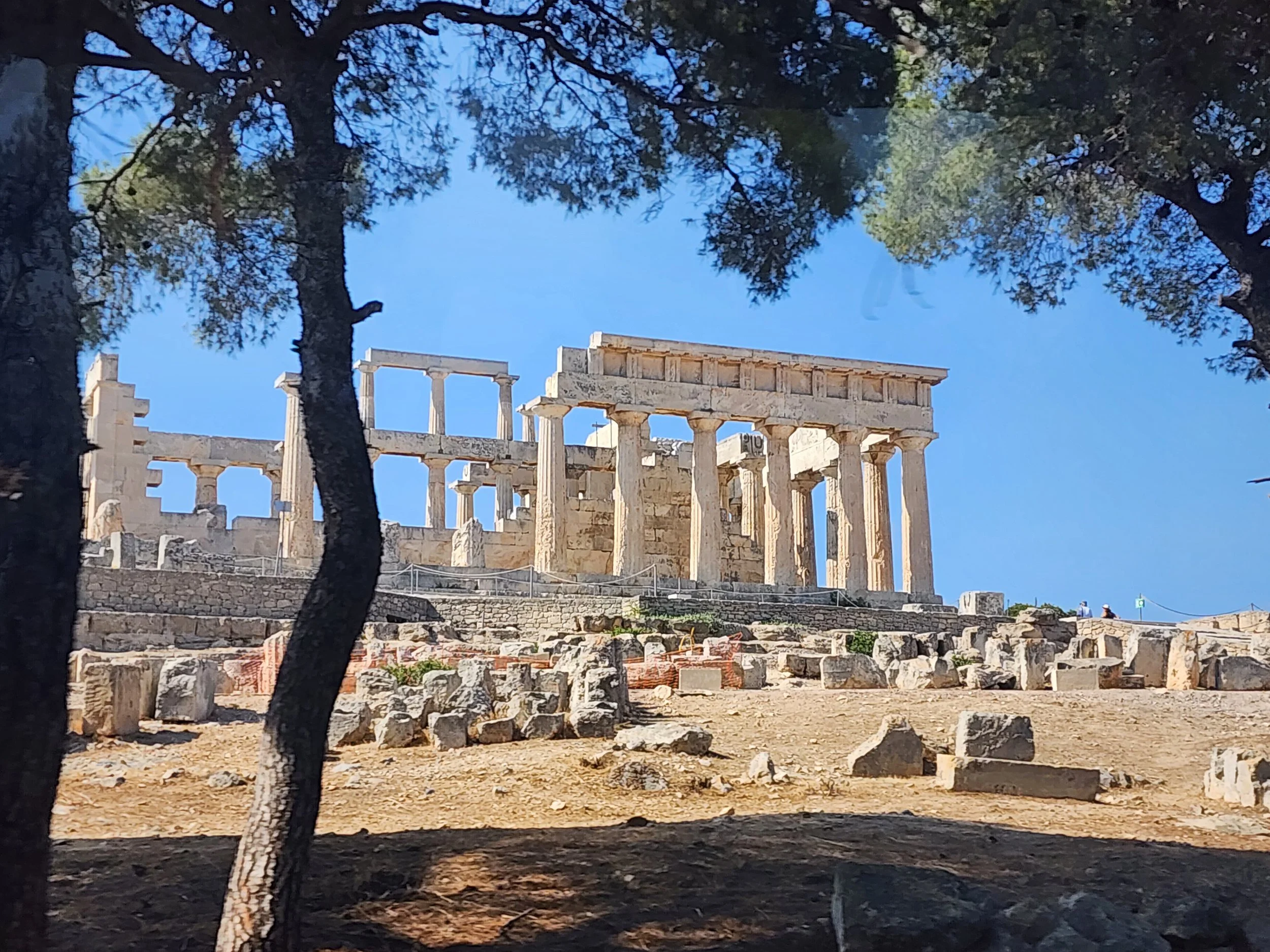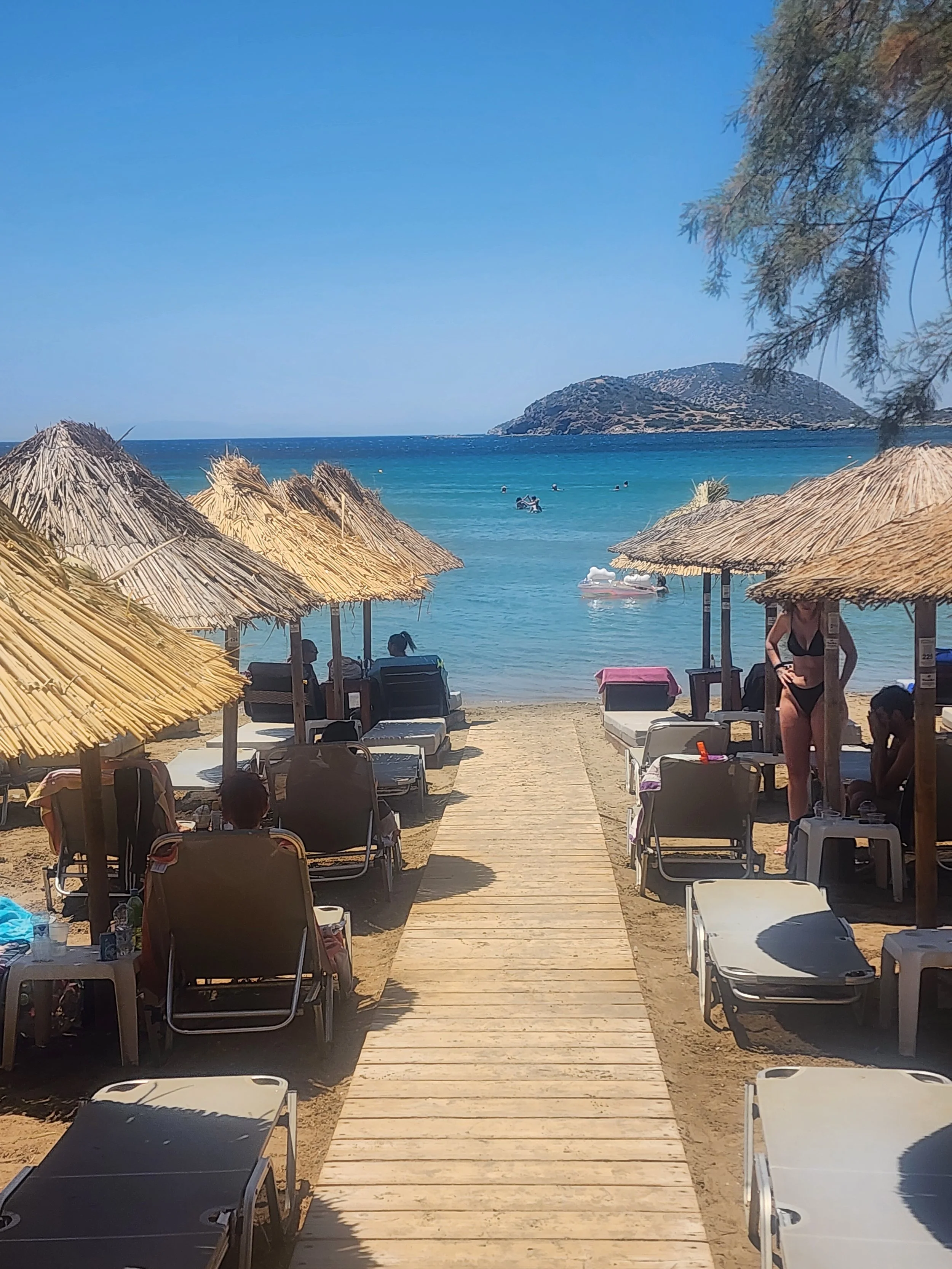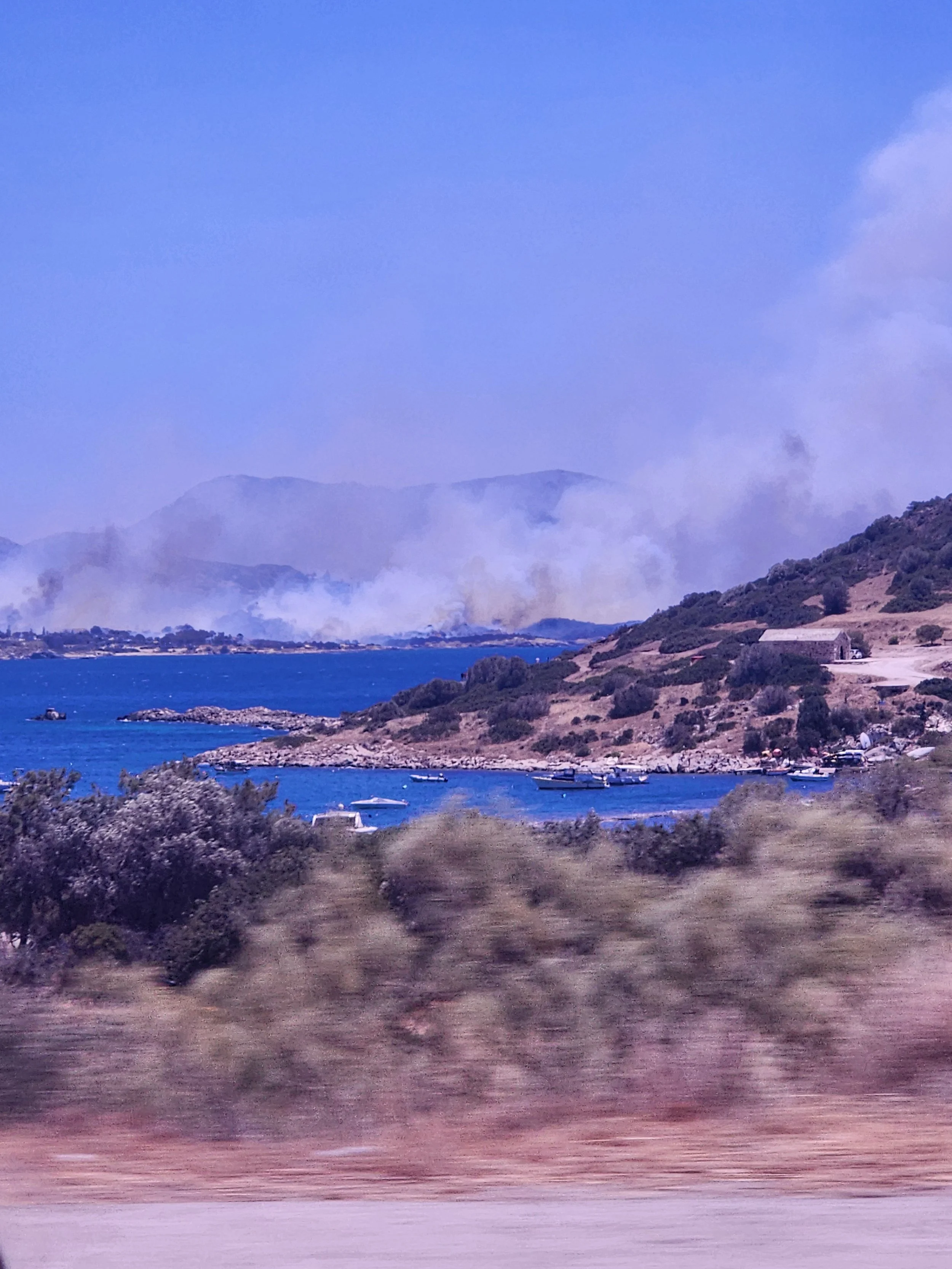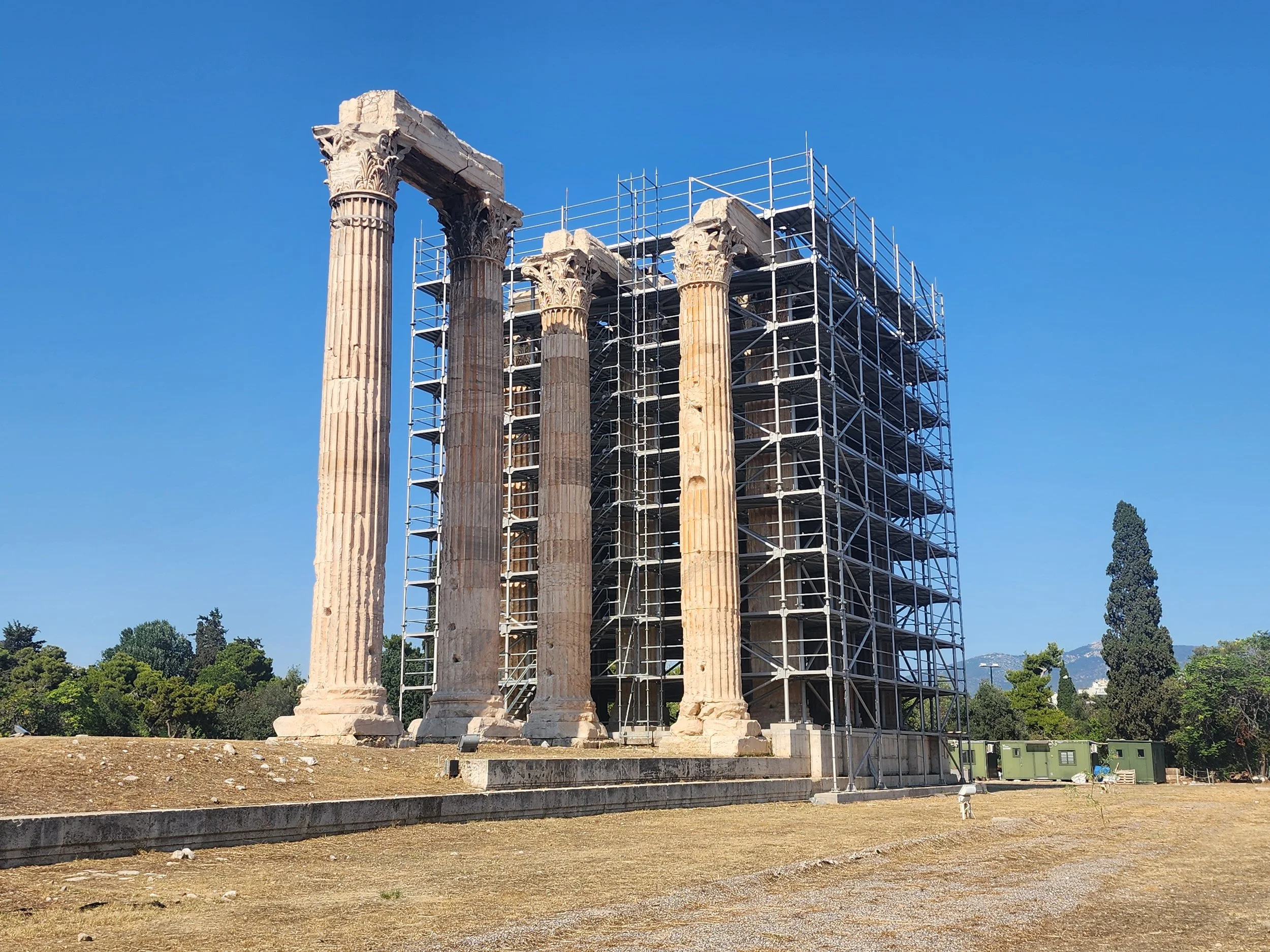Athens - Greece
Overview: A deep dive into Athens and the surrounding areas
Duration: 10 days, excluding travel, but including a wedding
Locations visited: Athens, Athens Riviera, Hydra, Aegina, Meteora, Delphi, Peloponnese
How to get there: Fly into Athens International Airport Eleftherios Venizelos (ATH)
How to get around: Taxis for Athens and the Athens Riviera. You can use the Uber app to request a taxi. For day trips, use tours or private cars.
When to go: May, September, and October, or April. The summer months can exceed 100°F and are extremely crowded. I went in late June, and the heat took away from the enjoyment of many sites, reducing the amount of time I spent at each. Prices are likely better slightly off-season. Note: While the islands are crowded in the summer, they are generally cooler than the mainland.
Pace: Moderate
Future trips: Explore other areas of Greece
Other notes:
As mentioned above, summer gets hot in Athens. If traveling again, I would go in the fall or spring. This is coming from someone who lives in a warm, tropical climate with year-round highs between 75°F and 90°F.
Greece is one of the most approachable countries I’ve visited as an American tourist — high levels of English fluency, a welcoming culture, cuisine with familiar flavors, and a generally safe environment (outside of potential pickpocketing, which is common in many European tourist destinations).
Delphi, Greece
Day 1: Day Cruise to Hydra, Poros, & Aegina
After arriving the previous night and checking into our hotel in Athens, we kicked off the trip with a full-day cruise to three of the Saronic Islands — Hydra, Poros, and Aegina. Since we weren’t spending any nights on the more famous Greek islands (Mykonos, Santorini, Crete, etc.), we thought the cruise would give us a taste of ferry travel and island-hopping. We booked with Athens Day Cruise, which offers hotel pickups and drop-offs in Athens, indoor and outdoor seating, and onboard food and drinks. While there are multiple cruise operators, and you could always take ferries yourself, this was one of the few itineraries that included three islands rather than two.
Our first stop, about two hours from the Athens port, was Hydra. Known for its whitewashed houses with reddish-brown roofs and its car-free streets, Hydra relies on walking, horses, and donkeys for transportation. With just over an hour to explore, we joined the walking tour offered by the cruise. We visited the Cathedral Church of the Assumption of the Virgin Mary, saw its clocktower and the Ecclesiastical Museum, and heard a few local legends. From there, we strolled past boutique shops and took photos before heading back to the port.
A short 30-minute sail brought us to Poros, a small island with a history that spans Roman, Byzantine, Venetian, and Ottoman control. It also served as the first naval base for the Greek War of Independence in 1827. Shops, cafés, and ice cream stands line the waterfront, and the island’s clocktower is a popular climb for panoramic views (which we skipped due to the heat).
Our final stop was Aegina, about an hour and a half from Poros. Here, the cruise offered three optional excursions — visiting historical sites, swimming, or tasting Aegina’s famous pistachio products. Since we didn’t have swimsuits and my friend is allergic to pistachios, we chose the historical tour.
The first stop was the Temple of Aphaia, dating to around 490 BC and dedicated to the goddess Aphaia, worshipped almost exclusively in Aegina. The temple is part of the so-called Sacred Triangle of ancient Greek temples — a nearly perfect isosceles triangle formed with the Parthenon in Athens and the Temple of Poseidon at Cape Sounion. It’s also one of the better-preserved temples in Greece.
Next, we visited the Monastery of Agios Nektarios, founded in the 20th century on the site of a 10th-century Byzantine monastery. From here, you can see Paleochora, the island’s medieval capital, scattered with the ruins of numerous churches and chapels across the hills.
After wrapping up our time in Aegina, we sailed for about an hour back to Athens, where we were dropped off at our hotel. We ended the day with dinner at the hotel before calling it a night.
Day 2: The Acropolis
For our second day in Athens, we toured the famous Acropolis. The word acropolis refers to the highest point of a city. While Athens has the most famous one, many other Greek cities also had acropolises, which often served as religious or defensive centers. The Acropolis of Athens was inhabited during the Neolithic period and became a fortified citadel during the Mycenaean period (1600–1100 BC). Around 800 BC, it was transformed into a religious site for temples before being destroyed by the Persians in 480 BC. It was rebuilt during the reign of Pericles. In later centuries, many temples were converted into churches. After the Greek War of Independence, the decision was made to restore the Acropolis to something resembling its state during Pericles’s rule. Excavation and restoration work continues today.
For visiting, I recommend booking an early morning tour (ideally one that includes the Acropolis Museum). Mornings are cooler and less crowded, and tours typically include skip-the-line tickets so you don’t have to purchase your own.
On the way up the hill, you’ll pass the Theatre of Dionysus Eleuthereus, birthplace of Greek tragedy, and the Odeon of Herodes Atticus, a theater built in 161 AD that is still used for performances today.
At the top, you’ll enter through the Propylaea, the grand gateway to the Acropolis. Just beyond it stands the small Temple of Athena Nike. The main attractions, of course, are the Parthenon and the Erechtheion. The Erechtheion is a temple dedicated to Athena Polias, Poseidon, and Hephaestus, while the Parthenon honors Athens’s patron, Athena. There are multiple photo opportunities from every angle. Be warned: if you visit on a hot day, there is almost no shade. Carry water, as there are no cafés, and the vending machines are cash-only.
At the western end of the Acropolis, there’s an elevated area with a Greek flag that makes for a great final photo stop. If the weather is tolerable and you have extra time, there are additional ruins and smaller sites on the hill worth exploring.
Since we booked a tour that included the Acropolis Museum, we headed there next. The museum sits at the base of the hill and is one of the best I’ve visited (and I’ve been to a lot of museums). It’s the perfect size — not overwhelming, but still detailed. The top floor houses a full replica of the Parthenon, while the basement level displays excavated ruins from beneath the museum itself. Having a guide is helpful, but the museum stands well on its own.
Afterward, we grabbed lunch on Makrigianni Street, just outside the museum. There’s a wide range of restaurants to choose from, though some require reservations, so plan ahead.
Later in the trip, I had another day to explore Athens, but if your time in the city is limited, you could definitely continue exploring after lunch. Since I knew I had a spare day and the heat was starting to wear us down, we decided to head back to the hotel and enjoy the air conditioning.
Day 3: Meteora
We booked a private tour to visit Meteora, about a 3–4 hour drive from Athens into the region of Thessaly (though there are also group tours, or you can rent a car). While it’s a bit of a trek, I would absolutely recommend a visit—it’s one of the most unique and spectacular places I’ve seen in my travels. Meteora is one of the few sites in the world designated a UNESCO World Heritage Site for both natural and cultural reasons. Rising from the foothills, massive 60-million-year-old sandstone rock formations jut out of the earth, and monks built monasteries perched on their peaks. The name Meteora means “suspended in the air.”
The first monks settled in Meteora’s caves as early as the 9th century, and began building the cliff-top monasteries in the 14th century. Their elevated position provided protection from the Ottomans, and historically, they were only accessible by ropes, pulleys, and ladders. At its peak, Meteora had 24 monasteries; today only six remain active, though you can still see ruins scattered across the landscape.
While there are hiking and biking routes to reach the monasteries, the quickest way is by car. Several viewpoints line the main road, perfect for photo stops.
All six monasteries are open to visitors, though most close 1–2 days per week, so it’s best to check schedules in advance—especially if there are specific ones you want to see. Entry is around €5 per monastery. Modest dress is required (covering knees and shoulders), but most sites provide shawls or wraps if needed.
We visited St. Stephen’s Monastery, Varlaam Monastery, and Rousanou Monastery. Great Meteoron Monastery, the largest, was closed for a private event that day. The other two active monasteries are St. Nicholas Anapausas and Holy Trinity.
Afterwards, we had lunch at Boufidis Greek Tavern in Kastraki. Nearby, the town of Kalabaka offers additional stops, including the Museum of Geological Formations of Meteora and the Natural History Museum of Meteora and Mushroom Museum. We then made the return drive to Athens.
What I didn’t know at the time—and only learned later back at the hotel—is that the oldest known man-made structure is located nearby, in Theopetra Cave. The cave was inhabited from 130,000 years ago until about 4000 BC, and inside stands a wall dating back 23,000 years. For context, the second-oldest known structure in the world is about 11,000 years old.
Day 4 - 6: Athens Riviera
After lunch near the Acropolis, I headed down to the Athens Riviera.
I had traveled to Greece for a friend’s wedding near Anavyssos, which is part of the Athens Riviera and about a 30–60 minute drive from central Athens depending on traffic. The area is filled with resorts, beaches, beach clubs, and restaurants. The water is calm enough for swimming and seems less susceptible to wind than some of the Aegean islands. And unlike the islands, you don’t need an additional flight or ferry to get there once you’ve arrived in Athens. Historically, there’s less to see in this area apart from the Temple of Poseidon.
After two days of wedding activities, I took a taxi back to my hotel in Athens, where I stayed for the remainder of the trip.
Day 7: Mycenae, Epidaurus, Nafplio, & Corinth
On my first day back in Athens, I booked a full-day group tour through Key Tours that covered the major sites of the Peloponnese. While the tour was efficient and well-priced, this was the one day I wished we had a rental car — it would have allowed us to see additional sites in the area. With a long day or an overnight stop, you could even visit Olympia, the original site of the Olympic Games.
We began with a brief stop at the Corinth Canal, about an hour outside of Athens. The canal connects the Aegean Sea to the Ionian Sea, eliminating the need to sail around the Peloponnese. Construction began in 67 AD under Nero, but due to technological limitations, it wasn’t completed until 1893. There are several archeological sites nearby if you have time to explore, including Ancient Corinth, Acrocorinth, the Temple of Apollo and its museum, Penteskoufi Castle, Castle of Fokas, and the Sanctuary of Hera at Perachora. Unfortunately, the group tour didn’t include these.
From there, we continued to Mycenae, a UNESCO World Heritage Site and home to Greece’s first advanced civilization from 1600–1100 BC. Highlights include the palace complex, underground cistern, museum, and the famous Lion Gate, one of the earliest large-scale sculptures in Europe. Nearby is the Treasury of Atreus (also known as the Tomb of Agamemnon), a massive beehive-shaped tomb carved into the hillside. Its dome, measuring 14.5 meters, was the largest in the world for over a thousand years. The elevated location of Mycenae once provided a strong defensive position and today offers sweeping views of the surrounding landscape.
We then drove south toward Nafplio. Along the way, there are additional Mycenaean ruins and the town of Argos, which has its own castle and ancient theater (worth visiting if you’re driving yourself).
Nafplio is a charming coastal town that served as the first capital of modern Greece after the War of Independence. The old town has a strong Venetian influence, a reflection of its history. If you have time, you can visit its two main fortresses, Palamidi and Akronafplia, or take a small boat out to Bourtzi Fortress, which sits on a tiny islet in the harbor. After wandering the town and browsing some local shops, I stopped for a bite to eat at a waterfront restaurant.
Our final stop was Epidaurus, about 30 minutes from Nafplio. Epidaurus is home to one of the best-preserved ancient Greek theaters, as well as the remains of the Sanctuary of Asclepius, the most important healing center in the ancient world. The sanctuary combined medicine with spiritual practice, and theater itself was believed to play a role in healing. Ruins at the site include the guesthouse, stadium, temple, and tholos, among others. The theater remains in use today for performances thanks to its extraordinary acoustics.
This wrapped up the tour, and we began the hour-and-a-half journey back to Athens.
Day 8: Temple of Poseidon
Day 8 was more relaxed than the previous ones. I booked a small-group half-day tour to the Temple of Poseidon at Cape Sounion. With a bit more planning, this visit could have been combined with my time in the Athens Riviera since the temple sits at the southern tip of the Attica Peninsula. But hindsight is 20/20, and in the end, it was nice to have a calmer day.
Most Temple of Poseidon tours are timed for sunset, but I opted for a morning visit since it’s less crowded, and because my evenings were filled with work calls during U.S. hours.
On the drive, we stopped briefly for photos at Lake Vouliagmeni before continuing along the coast. There are several scenic viewpoints on the way to the temple, offering panoramic views of the temple. The Temple of Poseidon, built around 440 BC during Athens’ Golden Age under Pericles, is one of the three temples that form the Sacred Triangle along with the Parthenon and the Temple of Aphaia on Aegina. It was constructed on the ruins of an earlier temple destroyed by the Persians. Just downhill are the remains of an ancient settlement.
After visiting the temple, we stopped at ParaDais Beach Bar, about 15 minutes away, for food, drinks, and optional swimming. Not long after we arrived, emergency alerts went off on everyone’s phones — a wildfire had broken out just south of where we had driven minutes earlier. The beach bar closed early, and we headed back to Athens to wrap up the tour.
Day 9: Exploring Athens
On the penultimate day of the trip, I set aside time to explore Athens beyond the Acropolis. As mentioned earlier, much of this could be combined with an Acropolis visit if you’re short on time, but I spread it out.
I started at the National Archaeological Museum, Greece’s largest museum, which houses artifacts from around 3000 BC to 150 BC, including Cycladic, Minoan, and Mycenaean art. The museum is home to the famous Mask of Agamemnon, discovered in the Mycenaean ruins I had visited the day before. Personally, I found the prehistoric collection in the center most engaging. The sculpture halls and inscriptions on the outer edges began to blend together after a while. There’s also an outdoor café where you can see finds from a 60 BC shipwreck.
From there, I took a cab to the Athenian Agora, located northwest of the Acropolis. Despite the site’s size, there’s only one entrance, which is on the north end off Adrianou Street. Excavation work is ongoing, and you can catch glimpses of it from the road. You’ll need a ticket to enter. Inside, the ruins are extensive, with the Temple of Hephaestus being the most intact. The Agora has been inhabited since the late Neolithic period, became Athens’ civic center in the 6th century BC, and remained in use through the Byzantine era. There’s also a museum and a Byzantine-era church (around 1000 AD) on-site.
Be warned: in summer, walking the Agora quickly becomes uncomfortable in the heat, and it definitely detracted from the experience. If possible, visit early in the morning or plan your trip during the off-season.
Just east of the Agora are the Roman Forum and Hadrian’s Library. Both require tickets, but since the sites are relatively small and fenced, you can see much of them from the surrounding streets. By this point, I had accumulated quite the stack of Greece’s blue-and-white archaeological entry tickets.
For food, there are plenty of restaurants and bars nearby in Monastiraki and Plaka. After a quick break, I headed toward Syntagma Square. On the way, I stopped at the Holy Metropolitan Church of the Annunciation to the Virgin Mary. At the square itself, you’ll find the Hellenic Parliament building, and just behind it, the National Gardens. The gardens feature over 500 plant species, scattered ruins, and, most importantly on a hot day, plenty of shade.
On the south side of the gardens are Zappeion Hall and its grounds. Continuing further, you’ll reach the Temple of Olympian Zeus. Its surviving columns soar to 54 feet — much taller than the Parthenon’s 34 feet — and the temple originally had more than twice as many columns. Nearby, you’ll find the Arch of Hadrian, which the Greeks built for Hadrian to thank him for not razing the city during the Roman rule.
That wrapped up my tour of Athens. If you haven’t already, I recommend ending your day at one of the city’s many rooftop bars, ideally one with a view of the Acropolis lit up at night.
Day 10: Delphi & Arachova
For my final full day in Greece, I booked a full-day group tour to Delphi and Arachova. Delphi is about a 2.5 hour drive into the mountains from Athens, depending on traffic.
The ancient Greeks believed Delphi was the center of the world, based on a legend that Zeus released two eagles from opposite ends of the earth, and they met here. Apollo is the main god associated with Delphi, although Dionysus was said to preside during the winter months. Delphi is most famous for the Oracle of Apollo, the high priestess who delivered cryptic prophecies, supposedly inspired by vapors rising from an underground chasm. No such chasm has ever been found, and it’s now widely accepted that the Oracle’s predictions came less from divine foresight and more from an elaborate system of gathering intelligence from the rulers who visited. Regardless, at the time, the Oracle was considered sacred, and Delphi became a major religious and cultural hub.
As a result, rulers and city-states built temples, treasuries, and monuments leading up to the Oracle along the Sacred Way. The most impressive of these is the Athenian Treasury.
Before walking the ruins, I highly recommend starting at the Delphi Archaeological Museum. It’s compact, air-conditioned, and houses many of the site’s key artifacts, including the Charioteer of Delphi statue. After about 30–45 minutes in the museum, head outside to the site itself.
Walking the Sacred Way, you’ll pass the Omphalos Stone, where Zeus’s eagles supposedly landed, a restored Athenian Treasury, and numerous temple remains. At the heart of the site stands the Temple of Apollo, next to a replica of the Serpent Column. The original stood at Delphi for 900 years to commemorate the Greek victory over Persia before being moved to Constantinople in 324 AD, where it remains today.
Continuing uphill past the Temple of Apollo, you’ll reach a remarkably well-preserved theater. If you’re up for another 10-minute climb, the path leads to the ruins of the ancient stadium. It’s not a difficult walk, and the panoramic views of the valley are well worth it.
Outside the main sanctuary are the Ancient Gymnasium and the Tholos of Athena Pronaia. Unfortunately, both have been closed to visitors in recent years due to rockslides, though plans exist to reopen them once it’s safe.
After Delphi, the tour stopped in Arachova, a mountain village known as a winter ski destination. (The slopes are about 30 minutes away, so you won’t spot chairlifts from town.) The village is picturesque, with reddish-brown roofs, narrow stone streets, and plenty of shops and tavernas. Its two main landmarks are the clock tower and the Church of St. George. If you get the chance, try formaela cheese, a local specialty produced only in Arachova.
We grabbed lunch in town before heading back to Athens. For my final evening in Greece, I capped things off with dinner and drinks at a rooftop restaurant, complete with one last view of the Acropolis lit up against the night sky.
—
This trip offered a little bit of everything — ancient ruins, mountain monasteries, island escapes, and even a wedding along the coast. Greece is one of the easiest destinations I’ve traveled as an American, yet it never felt ordinary or predictable. I left already thinking about the regions I’ll visit next time.













































































































